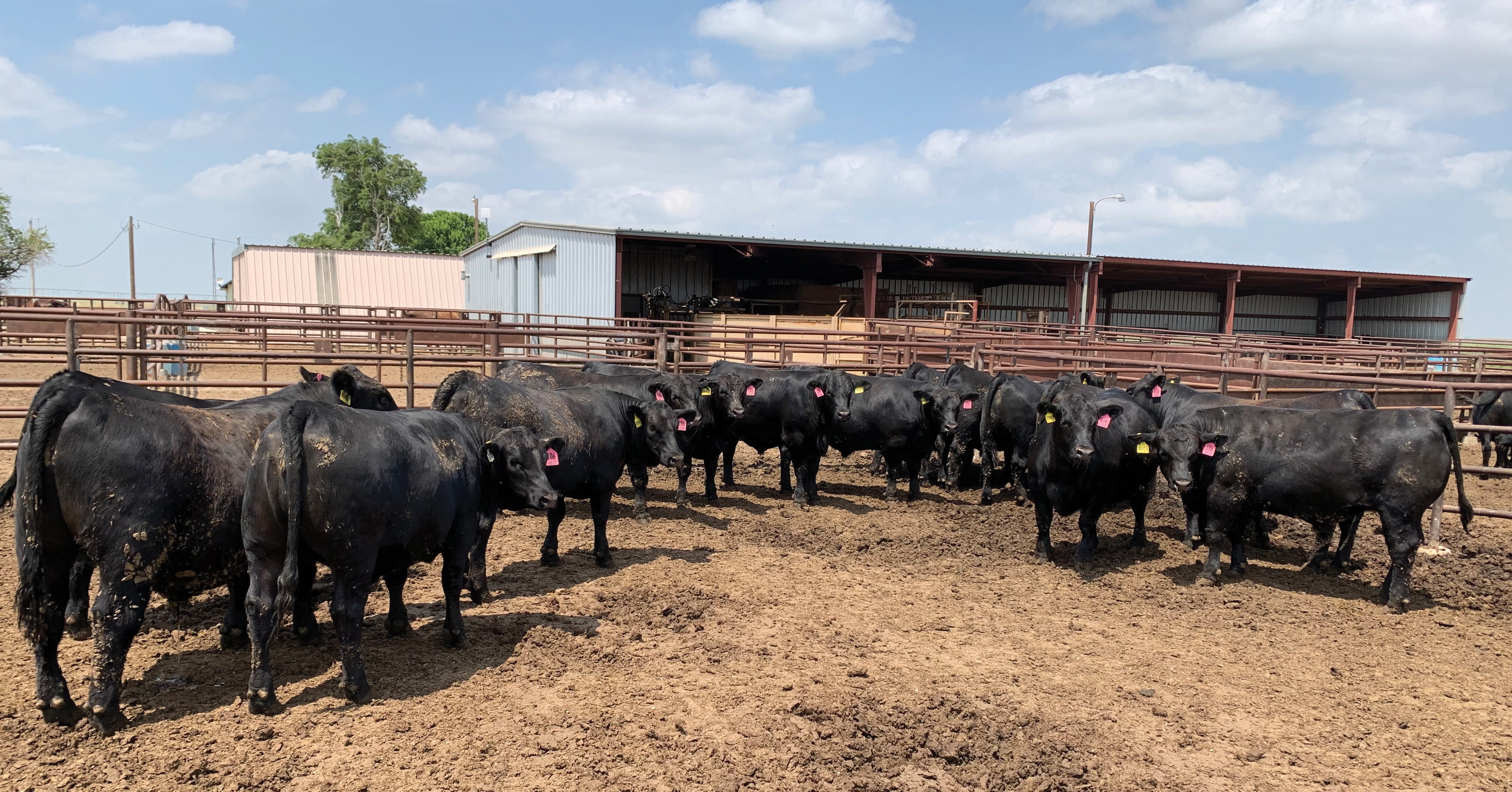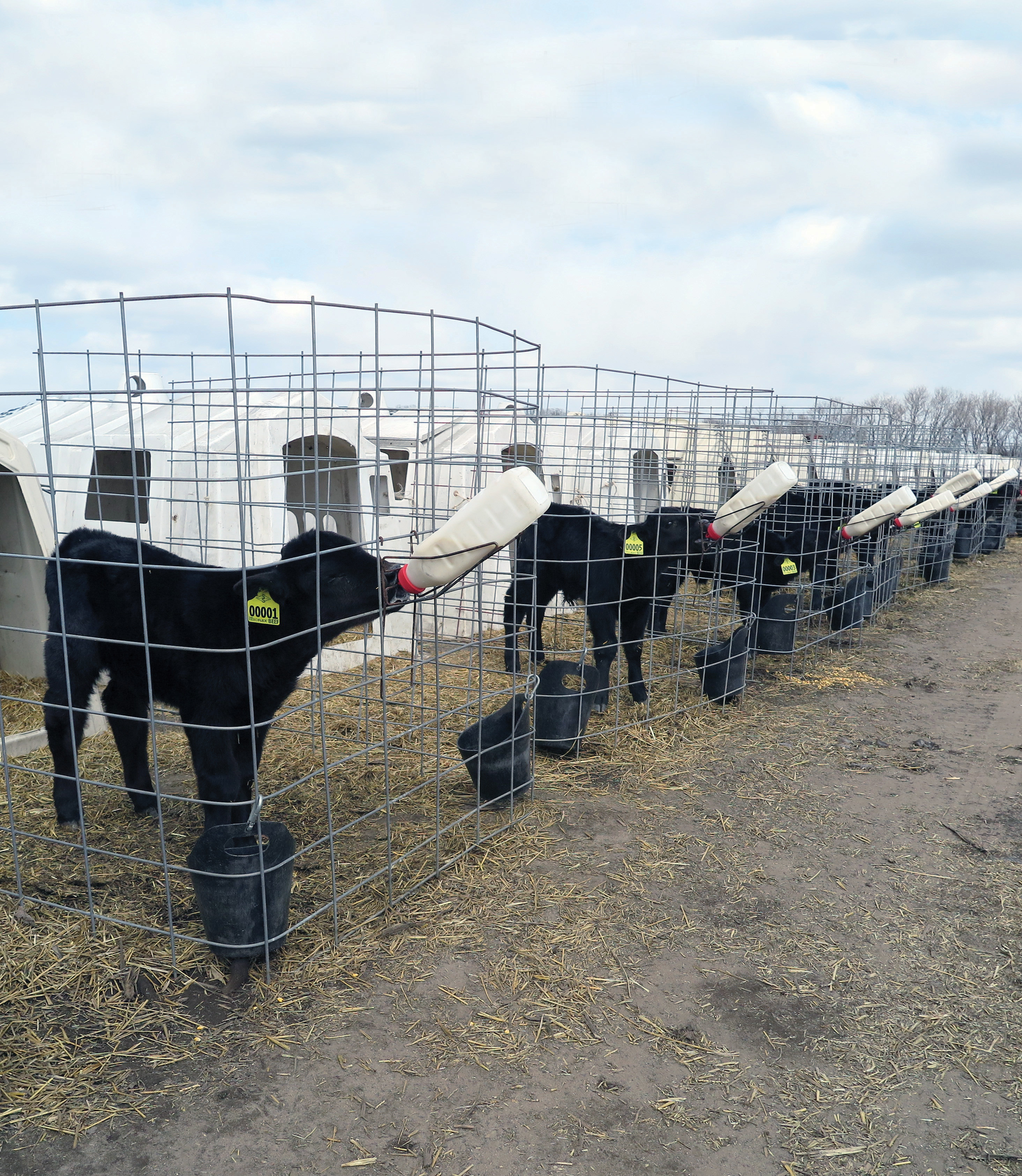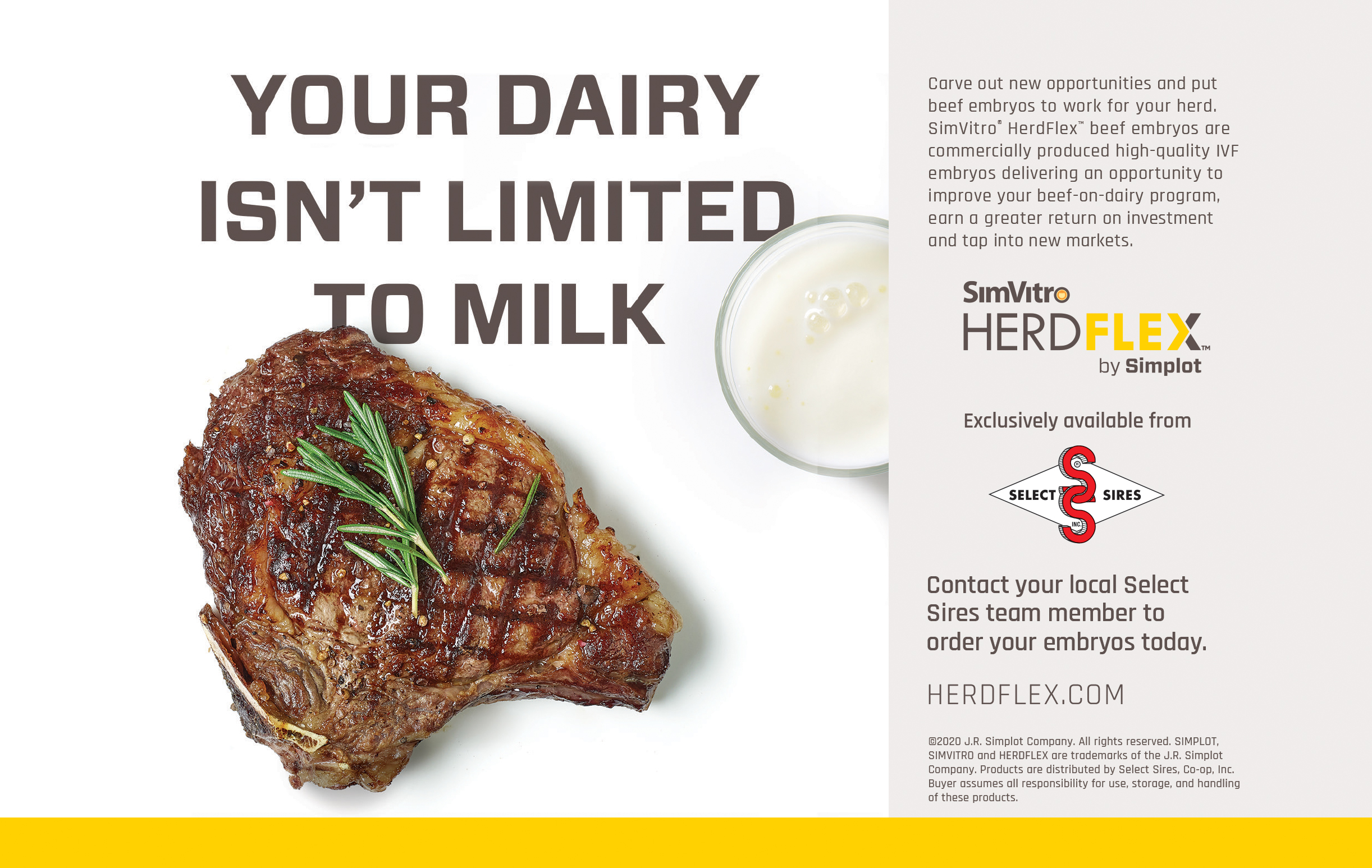
Kansas State compiled a summary of beef x dairy cross calves selling through Superior Livestock Auction compared to purebred Holstein steer calves and straight Angus-type calves selling at the same time. The data showed that the beef x dairy calves
at 550 to 600 pounds sold for $15 per hundredweight (cwt) under straight Angus-type calves. However, purebred Holstein steer calves were $40 per cwt under the beef price. Bottom line: beef x dairy calves brought about $80-$90 more per head than
Holstein steers. While there was no data in the study regarding Jersey bull calves, we can speculate they would fetch even less at market.
Crossbred beef x dairy calves are one thing, but what if a dairy farmer could use their current dairy herd resources to gestate a beef embryo and send a straightbred beef calf to market? If you’ll remember from the Kansas State study, pure Angus-type cattle garnered the highest price at Superior Livestock Auction. To take it a step further, imagine a dairy could supply a year-round source of calves out of high-performing terminal beef genetics, backed by committed management standards with confirmed traceability! This is the discussion sparked by Chris Sigurdson, general manager of Minnesota Select Sires Co-op, Inc., and Andrew Swanson, beef business manager, at a staff meeting in 2019 and then shared with others throughout the Select Sires federation.
The journey to beef out of dairy
Before we dig deeper, let’s back up and look at how the industry arrived at this point from Select Sires’ perspective.
Select Sires has been working alongside farmers for generations to maximize the profit potential of dairy operations. Throughout the years, we have introduced value-added programs including Select Mating Service® (SMS®)
and Select Reproductive Solutions® (SRS®).
Fast forward to the introduction of sexed semen and its subsequent improvements in fertility. Dairies embraced the technology that allowed them to generate an abundant supply of heifers. Profit-minded producers were quick to realize that the abundance of replacements was widespread, which meant they were left with extra stock that was not in high demand. Select Sires stepped in with ProfitMAX®.
ProfitMAX service professionals work with farm management to achieve long-term profitability from every genetic decision. An audit of each participating dairy’s reproductive records, cow and heifer inventories, as well as evaluation of each
animal’s genetic value are considered using proprietary inventory calculators and genomic test results, if the dairy has them, to determine the best possible pairing to generate profit. “It’s all about healthy uterus management,”
says Lyle Kruse, vice president of market development for Select Sires. “Some cows or heifers may carry a high-value gender SELECTED™ calf or embryo to enter the milking string as a replacement and advance the herd’s
genetic merit. Less genetically valuable heifers or cows may carry a beef calf to be sold immediately or retained to market weight to enter the beef supply chain. These decisions will maximize profits with every mating.”
“Three years ago, many dairy producers simply sought ‘cheap’ semen that would produce a black calf. Sadly, this created the cattle we have been seeing in feedlots and packing rails the past year or so,” says Dr. Larry Corah, professor emeritus, Kansas State and Select Sires’ beef supply chain development consultant. “As a result, the feeding/packing sector has started to push back by pricing these cattle at the same value as a Holstein steer.”
Select Sires introduced the ProfitSOURCE™ beef x dairy program in 2019. ProfitSOURCE sires are hand selected for crossbreeding on Holsteins and Jerseys. These sires excel for calving ease, growth performance, carcass merit and offer elite fertility
to maximize reproductive performance. ProfitSOURCE is a complete beef x dairy program producing offspring to meet the desires of growers and packers throughout the supply chain, including committed management standards for offspring as well as
specific tagging for easy traceability.
Select Sires launched a multi-year initiative seeking to create value from dairy producers to beef consumers. Numerous meetings with calf ranches, feeders and packers provided a great deal of direction. It was clear that each desired a steady supply of predictable outcomes.
“By leveraging performance-based terminal genetics, committed management standards and a sound tagging system for traceability, it became clear that our farmer-owners could deliver what the supply chain wanted,” says Swanson. Calf ranches,
feedlots and packers interested in source-verified, high-quality ProfitSOURCE calves have established partnerships with Select Sires as demand is growing.
Still, there was the thought that the highest premium opportunity might come from straightbred beef calves made in a dairy production system. “We had a vision that we could maximize genetic potential and consistency and take advantage of dairy system attributes of healthy, year-round scaled production and traceability,” says Swanson. “That’s where the idea for HerdFlex™ was really founded to use embryo transfer,” says Sigurdson. “This is a beef production strategy designed to maximize calf value. Dairies contribute their extra pregnancies, calf-raising expertise and the year-round production system.”
After discussions with Simplot®, Select Sires became the exclusive supplier of SimVitro® HerdFlex beef embryos in the U.S. “Early in the partnership with Simplot, we trained some of our best technicians and put
together an embryo trial to test our vision,” says Swanson.
“The dairyman must see an economic advantage,” says Swanson regarding the addition of a beef embryo program. Minnesota Select Sires quickly set a trial in motion with the assistance of four dairies in central and southeast Minnesota. From June 2019 through February 2020, genetically elite beef embryos were transferred. All cows with embryos transferred were previously assigned mating to beef and randomly chosen for embryos. The only culling from the group was if a cow was unlikely to still be in the herd at calving or if, upon palpation, a cow was thought to be cystic. If there was no evidence of a corpus luteum, embryos were transferred on the side with the largest ovary. To provide comparison, a group of cows were also bred with beef semen.
"We were pretty pleased with the results. Conception rates for the embryos were within -.55% of the beef semen." -
Andrew Swanson
June 2019 - February 2020 Beef Embryo Trial
| Beef Embryos | Beef Semen |
|---|
| 146 Pregnancies | 971 Pregnancies |
|---|
| 398 Total Embryos Transferred | 2,608 Total Units Used |
|---|
| 36.68% Conception | 37.23% Conception |
|---|
June 2019 - September 2019
| Beef Embryos | Beef Semen |
|---|
| 91 Pregnancies | 438 Pregnancies |
|---|
| 228 Total Embryos Transferred | 1,288 Total Units Used |
|---|
| 39.91% Conception | 34.01% Conception |
|---|
“Through the study, we learned that in times of heat stress while semen performance often lags, embryo performance in the trial during June through September was 6 percent better than that of high-fertility beef semen,” says Swanson. “With conception on a dairy being of the utmost importance, we knew going into this venture that keeping pregnancy rates as high as possible would be a must, so this data was reassuring.”

Starting in March of 2020, calves began to arrive and initially either stayed on the farm or went to the farm’s calf raiser and they were handled and fed just like their dairy calves: fed colostrum, navels dipped, appropriately tagged, placed in a calf hutch, fed waste milk or milk replacer, calf starter was made available along with water. All calves received appropriate vaccinations and males were castrated. Calves were weaned in July and August at about 250-300 pounds and were then transferred to a grower in southwest Minnesota.
In January of 2021, study calves arrived at Sam Hands’ Triangle H Feedlot in Garden City, Kansas in two groups, based on age and size. To allow for the comparison of growth performance data one group of calves was placed on a feedlot and a second group was turned out to wheat pasture to assess whether these straight beef cattle that had been raised in a dairy system would be able to graze and convert forage into pounds of product at harvest.
End results and what we’ve learned
“When they arrived, the HerdFlex calves looked like stout, traditional Angus cattle in the feed yard, as expected they were very uniform, peas in a pod,” says Hands. The first calves were shipped for harvest in late July through late August.
“Over the same period of time, the beef x dairy calves required more feed to reach market weight. The HerdFlex cattle had better overall feed conversion,” says Hands. The added value of HerdFlex calves is seen when they are harvested and sold on a grid. The Triangle H HerdFlex calves were sold on the U.S. Premium Beef grid and graded 74 percent Prime and Premium Choice (Certified Angus Beef), netting a premium of over $150 per carcass.
Triangle H Consumption Report
| Larger Feedlot HerdFlex Calves | 4.09 ADG |
|---|
| Smaller/Wheat Pasture Grazed HerdFlex Calves | 3.13 ADG |
|---|
| Feedlot Beef x Dairy Calves | 3.63 ADG
|
|---|
"I think beef x dairy has been a nice bridge to the quality and uniformity gap of traditional beef. It has been an easy way to improve what is basically a byproduct from
dairies. If a dairy farmer is willing to make additional effort to improve and think about it as a profit center rather than a byproduct, HerdFlex may be for them! We could see great demand from packers for HerdFlex cattle if we can assure a consistent, uniform product, year-round in terms of end product delivered." - Sam Hands
Swanson suggests that HerdFlex embryos be used in conjunction with a beef x dairy program as a way to decrease the level of risk. He reminds producers interested in embryos that the cost to produce a HerdFlex calf, compared to a beef x dairy calf
can be as much as an additional $150. “I can’t emphasize enough the importance of well-trained embryo technicians to the success of the venture,” says Swanson. “That’s the biggest lesson we have learned to date. To
garner the most success with SimVitro’s embryo technology, the ideal recipient is first or second service, first lactation females. Later lactation cows are probably better candidates for beef semen. Taking these measures will keep pregnancy
rates in line. We will never lose sight of the fact that our farmer-owner’s primary income is from the sale of high-quality milk!”
